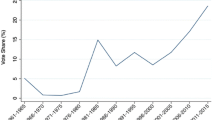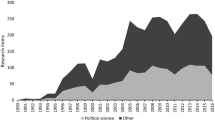Abstract
We calculate the rally 'round the flag effect (Mueller, 1970, 1973) for all 41 U.S. foreign policy crises, 1950–1985, identified by the International Crisis Behavior Project (Wilkenfeld, Brecher, and Moser, 1988). The mean change in the president's approval rating is surprisingly small: 1.4 percent among all respondents. The greatest influences on the rallying effect of a crisis are whether or not the United States is involved in an ongoing war and, especially, theNew York Times's coverage of the president's major response to a crisis. When a major response is reported in the headlines, the rally is more than 8 percentage points greater,ceteris paribus, than when it is not reported on the front page. TheNew York Times's reporting is influenced by the nature of the president's response, the efforts of his administration to publicize his actions, the degree of Soviet involvement, the location of the crisis, and the willingness of opposition leaders to take a newsworthy position regarding the president's performance.
Similar content being viewed by others
References
Apple, R. W., Jr. (1992). White House race is recast: No Kremlin to run against.New York Times, February 6, p. 1.
Applebome, Peter (1991). War heals wounds at home, but not all.New York Times, March 4, p. 1.
Berke, Richard L. (1993). Poll shows raid on Iraq buoyed Clinton's popularity.New York Times, June 29, p. A5.
Blechman, Barry, and Stephen Kaplan, with others (1978).Force Without War. Washington, DC: Brookings.
Brecher, Michael, and Patrick James (1986).Crisis and Change in World Politics. Boulder, CO: Westview.
Brecher, Michael, and Jonathan Wilkenfeld (1988).Crisis, Conflict and Instability. Oxford: Pergamon.
Brecher, Michael, and Jonathan Wilkenfeld (1990). International Crisis Behavior Project, 1929–1985 (Computer file). College Park, MD: Michael Brecher and Jonathan Wilkenfeld, University of Maryland (producers), 1989. Ann Arbor, MI: Inter-university Consortium for Political and Social Research (distributor).
Brecher, Michael, Jonathan Wilkenfeld, and Sheila Moser (1988).Crises in the Twentieth Century, Vol. I: Handbook of International Crises. Oxford: Pergamon.
Brody, Richard (1984). International crises: A rallying point for the president?Public Opinion 6:41–43, 60.
Brody, Richard A. (1991).Assessing the President. Stanford, CA: Stanford University Press.
Brody, Richard A., and Catherine R. Shapiro (1989). A reconsideration of the rally phenomenon in public opinion. In Samuel Long (ed.),Political Behavior Annual. Boulder, CO: Westview.
Callaghan, Karen J., and Simo Virtanen (1993). Revised models of the “rally phenomenon”: The case of the Carter presidency.Journal of Politics 55:756–764.
Darcy, R., and Sarah Slavin Schramm (1979). Comment on Kernell.American Political Science Review 73:543–545.
Edwards, George C., with Alec M. Gallup (1990).Presidential Approval. Baltimore: Johns Hopkins University Press.
Friedman, Thomas L (1992). Bush says politics is not motivation in plans for Iraq.New York Times, August 17, p. 1.
Gallup, George H. (1972).The Gallup Poll: Public Opinion 1935–1971, vol. 2. New York: Random House.
Gelb, Leslie H. (1992). Ousting Saddam or trapping Bush.New York Times, January 24, p. 13.
Hildebrand, David, James Laing, and Howard Rosenthal (1977).Prediction Analysis for Cross Classifications. New York: Wiley.
Holsti, Ole R. (1992). Public opinion and foreign policy: Challenges to the Almond-Lippmann consensus.International Studies Quarterly 36:439–466.
Hugick, Larry, and Alec M. Gallup (1991). “Rally events” and presidential approval. Paper presented at the annual meeting of the American Association for Public Opinion Research.
James, Patrick, and John R. Oneal (1991). The influence of domestic and international politics on the president's use of force.Journal of Conflict Resolution 35:307–332.
Jentleson, Bruce W. (1992). The pretty prudent public: Post post-Vietnam American opinion on the use of military force.International Studies Quarterly 36:49–74.
Jordan, Donald L., and Benjamin I. Page (1992). Shaping Foreign Policy Opinions: The Role of TV News.Journal of Conflict Resolution 36:227–241.
Kagay, Michael R. (1991). History suggests Bush's popularity will ebb.New York Times, May 22, p. 11.
Kernell, Samuel (1978). Explaining presidential popularity.American Political Science Review 72:506–522.
Kernell, Samuel (1986).Going Public: New Strategies of Presidential Leadership. Washington, DC: CQ Press.
Lee, John R. (1977). Rallying 'round the flag.Presidential Studies Quarterly 7:252–256.
Lewis-Beck, Michael S. (1980).Applied Regression. Newbury Park, CA: Sage.
Lian, Brad, and John R. Oneal (1993). Presidents, the use of military force, and public opinion.Journal of Conflict Resolution 37:277–300.
MacKuen, Michael (1983). Political drama, economic conditions, and the dynamics of presidential popularity.American Journal of Political Science 27:165–192.
Marra, Robin F., Charles W. Ostrom, and Dennis M. Simon (1990). Foreign policy and presidential popularity.Journal of Conflict Resolution 34:588–623.
Morgan, T. Clifton, and Kenneth N. Bickers (1992). Domestic discontent and the external use of force.Journal of Conflict Resolution 36:25–52.
Mueller, John E. (1970). Presidential popularity from Truman to Johnson.American Political Science Review 64:18–34.
Mueller, John E. (1973).War, Presidents, and Public Opinion. New York: Wiley.
Nincic, Miroslav (1992). A sensible public: New perspectives on popular opinion and foreign policy.Journal of Conflict Resolution 36:772–789.
Oneal, John R. (1988). The rationality of decision making during international crises.Polity 20:598–622.
Oneal, John R., and Bradley Lian (1992). A reexamination of the domestic and international influences on the president's use of force. Paper presented at the annual meeting of the American Political Science Association.
Ostrom, Charles W., and Brian L. Job (1986). The president and the political use of force.American Political Science Review 80:541–566.
Ostrom, Charles W., and Dennis Simon (1985). Promise and performance: A dynamic model of presidential popularity.American Political Science Review 79:334–358.
Phillips, Kevin (1990). Morning Edition, National Public Radio. November 1.
Russett, Bruce (1990a).Controlling the Sword. Cambridge, MA: Harvard University Press.
Russett, Bruce M. (1990b). Economic decline, electoral pressure, and the initiation of international conflict. In Charles S. Gochman and Alan Ned Sabrosky (eds.),Prisoners of War? Lexington, MA: Lexington Books.
SAS Institute (1989).SAS/Stat Users' Guide, version 6, vol. 2, 4th ed. Cary, NC: SAS Institute.
Schorr, D. (1992). Weekend Edition, National Public Radio. March 14.
Sciolino, Elaine (1994). U.S. offers plan to avoid threat from Iraq again.New York Times, October 13, p. 1.
Stimson, James A. (1976). Public support for American presidents.Public Opinion Quarterly 40:1–21.
Tyler, Patrick E. (1992). U.S. said to plan raids on Baghdad if access is denied.New York Times, August 16, p. 1.
U.S. Department of Labor (1991).CPI Detailed Report, June 1991. Washington, DC: U.S. Government Printing Office.
Van Belle, Doug (1992). Domestic political imperatives and dramatic uses of force. Paper presented at International Studies Association annual meeting, Atlanta, GA.
Waltz, Kenneth (1967). Electoral punishment and foreign policy crises. In James N. Rosenau (ed.),Domestic Sources of Foreign Policy. New York: Free Press.
Wilkenfeld, Jonathan, Michael Brecher, and Sheila Moser (1988).Crises in the Twentieth Century, vol. II: Handbook of Foreign Policy Crises. Oxford: Pergamon.
Wittkopf, Eugene R. (1994). End of the Vietnam Syndrome? Domestic sources of international orientation change. In Charles F. Hermann, Margaret G. Hermann, and Richard K. Herrmann (eds.),Changing Course in Foreign Policy. Pittsburgh: University of Pittsburgh Press.
Wittkopf, Eugene R., and Mark J. Dehaven (1987). Soviet behavior, presidential popularity, and the penetration of open political systems. In Charles F. Hermann, Charles W. Kegley, Jr., and James N. Rosenau (eds.),New Directions in the Study of Foreign Policy. Boston: Unwin Hyman.
Zelikow, Philip D. (1987). The United States and the use of force. In George K. Osborn et al. (eds.),Democracy, Strategy, and Vietnam. Lexington, MA: Lexington Books.
Author information
Authors and Affiliations
Rights and permissions
About this article
Cite this article
Oneal, J.R., Bryan, A.L. The rally 'round the flag effect in U.S. foreign policy crises, 1950–1985. Polit Behav 17, 379–401 (1995). https://doi.org/10.1007/BF01498516
Issue Date:
DOI: https://doi.org/10.1007/BF01498516




